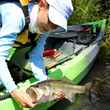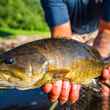It’s that time of year in southern Florida and throughout much of the Caribbean — big migratory tarpon are in near-shore waters and they’re prime targets for 10-weight-wielding fly anglers.
But the juveniles are active, too — fish up to 20 pounds are moving through Everglades canals and mangrove creeks all over the tropics. For saltwater anglers who’ve tasted the tarpon Kool-Aid, it’s the best time of the year.
But what to throw at the Silver King? There are lots of tarpon fly choices, and, frankly, tarpon flies are kind of all over the map. Last fall while fly fishing Ascension Bay, my buddy Alvin and I got into solid backcountry tarpon using black and purple Slumpbusters. A week later, a bit farther south on Chetumal Bay, the guides had us throwing chartreuse Tarpon Toads at 25-pounders hovering over a cenoté. In the Keys, the classic Cockroach still gets a lot of love.
With so many choices, the answer to what to throw isn’t always clear and you’ll get no shortage of conflicting opinions. With that in mind, here are some favorites for your springtime tarpon pursuits.

The Palolo Worm
Most fly anglers who go after tarpon are more likely to go with dependable baitfish patterns — and that is totally fine. But you can tell you’re in the boat with a serious tarpon angler when his box bristles with foam Palolo Worm and Palolo Spider patterns. The folks who throw these things are imitating the little red worms indigenous to the tropic all over the globe, and you never know when a tarpon — any tarpon — might decide to grab something that’s more “natural” than anything else fly fishers throw at them over the course of a season.
More Like This
These red, wormy patterns kind of skitter across the surface, offering both a bit of interesting disturbance and something that looks like a familiar food source for both migrating and backcountry juvenile tarpon. They’re fun to cast and that near-the-surface gulp when a tarpon goes after the worm is pretty cool, too.

The Kingslayer
This is a more traditional baitfish pattern, but with a twist. RIO ties these patterns using maribou and some fairly light barbell eyes — it’s a light fly, but once its wet, it’s going to get down a bit. The Kingslayer is a good searching pattern for backcountry fish, as it’s going to move up and down through the water column and move a lot of water. As a side note, a couple of summers ago, I caught a really nice snook from the beach using a Kingslayer.

The Tarpon Toad
Tied in colors ranging from tan and olive to purple and bright yellow, the Tarpon Toad is one of the most common tarpon flies out there. I like the Toad because it doesn’t weigh a ton, and, even when it gets wet, it’s sparse enough to avoid that “I’m casting a soggy diaper” feel. The head and collar are usually tied with EP brush or EP fibers that shed water nicely, and the tail can be something simply like a strip of rabbit fur or a clump of marabou. Either iteration seems to work just fine and both serve to give the Toad some “swim” on the retrieve.
The Slumpbuster
Nothing like taking a common trout and bass streamer and modifying it for saltwater. This is perhaps the easiest fly to tie, and it’s a quick tie, too, which is nice for globe-trotting anglers who might have opted for a traveling vise and a handful of materials in order to match what local guides and anglers are throwing. The Slumpbuster’s main ingredient is rabbit fur, both for the tail and the collar (I wrap the collar just like I would wrap a hackle — Palmered up the shank to the head). You can add a couple wraps of marabou hackle, if you like, to kind of “contain” the rabbit fur and ensure it leans toward the bend in the hook. But, as with most tarpon patterns, less material tends to be better. For the head, to avoid adding weight, I do a simple whip-finish and then put on a drop of UV resin to hold everything together. Again, the colors are variable, but black and purple seem to be the most popular.

The Dread Pirate
Princess Bride fans, this one’s for you. A packed deer-hair head with foam eyes make this an in-the-film water-mover, and, for a couple of reasons, a lot of anglers go with this pattern for sight-fishing. First, the Dread Pirate is easy for the angler to see on the water, and it will pop and skitter and make all kinds of racket, just to get attention (although, at last check, it’s yet to don a holocaust cloak and light itself on fire). Anglers like it. Tarpon like it. That’s a recipe for success.
BONUS FLY: The Tarpon Dragon
This is basically a Tarpon Toad or a Slumpbuster tied with a Dragontail. Some anglers despise the idea of a Dragontail added to any streamer, but after watching everything from giant northern pike to backcountry tarpon go out of their way to eat flies tied with this material, I’m a full-on convert. It’s a very seductive swimmer, and, tied with a bit of flash and a collar of rabbit strip, EP brush or marabou hackle, it crafts a deadly tarpon fly. I’ve had my best luck with this fly blind-casting in the creeks and hidden mangrove haunts of the Yucatan hinterlands. Again, purple and black seem to be the go-to colors, but my guide in Chetumal Bay last fall tied a few of these in white and yellow. Quick pro tip: when tying with Dragontail, either burn the tip of the tail with a butane lighter or apply a dollop of super glue to the tail. Otherwise, this material tends to unravel.

































Comments